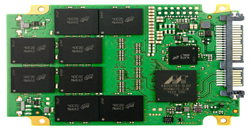ال اس اس دي – تطور الفلاش
ال اس اس دي هارديسك تطور الفلاش
في الجزء الثالث سنستعرض اهم انواعه واستخداماته
مع شرح مختصر لابرز محتواه من الداخل
A solid-state drive (SSD, also known as a solid-state disk[1][2][3]) is a solid-state storage device that uses integrated circuit assemblies as memory to store data persistently. SSD technology primarily uses electronic interfaces compatible with traditional block input/output (I/O) hard disk drives (HDDs), which permit simple replacements in common applications.[4] Additionally, new I/O interfaces, like SATA Express and M.2 have been designed to address specific requirements of the SSD technology.
SSDs have no moving mechanical components. This distinguishes them from traditional electromechanical magnetic disks such as hard disk drives (HDDs) or floppy disks, which contain spinning disks and movable read/write heads.[5] Compared with electromechanical disks, SSDs are typically more resistant to physical shock, run silently, have lower access time, and lower latency.[6] However, while the price of SSDs has continued to decline over time,[7] consumer-grade SSDs are (as of 2016) still roughly four times more expensive per unit of storage than consumer-grade HDDs.[8]
As of 2015, most SSDs use MLC NAND-based flash memory, which is a type of non-volatile memory that retains data when power is lost. For applications requiring fast access but not necessarily data persistence after power loss, SSDs may be constructed from random-access memory (RAM). Such devices may employ batteries as integrated power sources to retain data for a certain amount of time after external power is lost.[4]
Hybrid drives or solid-state hybrid drives (SSHDs) combine the features of SSDs and HDDs in the same unit, containing a large hard disk drive and an SSD cache to improve performance of frequently accessed data.[9][10][11]
انور الكندري – Kuwait Data Recovery
خبير استرجاع البيانات بالكويت منذ عام 1997
Anwer Alkandri, Forensic Data Recovery Engineer










